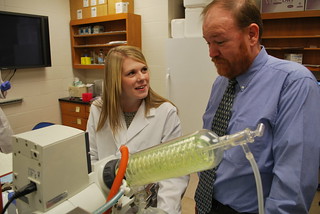Pharmacy faculty, engineering student find common ground in research collaboration
Rusty Arnold, an associate professor in Auburn’s Harrison School of Pharmacy, believes in academic units working together and crossing departmental lines to further research.
That collaboration does not stop at the faculty level as Arnold, a recipient of the President’s Collaborative Units Award, also benefits from the work of undergraduate students such as chemical engineering major Christy Pickering.
Pickering, a senior from Hazel Green, Alabama, was recently awarded a $5,000 Gateway to Research Scholarship from the American Foundation for Pharmaceutical Education for her work in Arnold’s lab, called “Development and Application of Gold‐Lipidic Nanocomposites to Enhance Chemotherapeutic Delivery and Release.” She was one of seven recipients nationally.
The purpose of the scholarship is to support faculty-mentored research in the pharmaceutical sciences. For Pickering, an active student who has been a member of the Auburn University Marching Band the last four years, the funding will assist with tuition and research expenses in her final year at Auburn.
“Christy is very intelligent, extremely motivated and very thorough. What is unique about her is that most of the undergraduate honor students that I work with are pre-med and she is chemical engineering,” said Arnold. “She has a clear vision that she wants to go into research, she wants to go into academia.”
Pickering is in her second year in Arnold’s lab, coming on board shortly after he arrived on campus. For someone who knew she wanted to work in the medical field, it was a perfect match.
“I applied because I thought what Dr. Arnold did sounded really cool – working with cancer, looking at chemo – it just sounded like a project I would really be interested in,” said Pickering. “So I sat down with him and talked about the project, and he took on me and four other undergrads. My project, from the start, was set up to be a very engineering-based pharmaceutical project. It has been a really neat experience getting to work with him.”
For Arnold, Pickering stood out right away as someone who would bring a new approach and think outside of the box in his lab. Bringing on someone with a chemical engineering background has added a new perspective to his research.
“What immediately caught my interest in Christy is when I described some of the challenges with the formulations, she was asking have you tried composites, have you tried these other things. She was immediately thinking about how to solve the problems,” said Arnold. “She has been able to take a system we are working with and propose changes that are actually going to allow us to deliver more than one drug, use more than one imaging modality, and hopefully be able to improve therapy. Using her background in engineering, she is able to add value in an area that my lab did not have expertise in. Even though she is an undergraduate, some of the ideas she has are very different than some of the approaches we would use.”
Part of Pickering’s research is working with liposomes, small spherical particles commonly used for chemotherapeutic delivery because they capitalize on a unique quality of tumors called the enhanced permeability and retention effect, or the EPR Effect. In order for tumors to grow quickly, they stimulate the production of blood vessels, but the quick growth causes them to not be as organized as they are in the rest of the body and the cell wall is more porous.
“The cells aren’t fully connected in some places, which means there are holes that things can transport through,” said Pickering. “The holes are very small, but big enough that liposomes or drugs can pass through into the tumor cells.”
Liposomes, like the ones that Pickering works with in Arnold’s lab, can circulate the body for a long time. When they get to a tumor, holes in the tumor vessels allow the liposomes to pass from the blood into the space outside the blood vessel where the tumor is located.
“We can put these long-circulating liposomes into the body and just let them go through the blood stream until they passively accumulate in the tumor site,” said Pickering. “The treatment called Doxil is a liposome with the chemotherapeutic drug doxorubicin encapsulated within it.
“So, using the EPR Effect is a passive means of targeting a tumor because you are just relying on the liposomes to naturally accumulate there by passing through the blood vessel. What we are trying to do is use active targeting where there will be something on the liposomes that actually targets the cancer cell and not the other cells in the body.”
Specifically, what Pickering has been working on is using the liposomes with the doxorubicin as a treatment method, but also incorporating gold nanoparticles as an imaging contrast agent to be able to look at the tumors.
“If we can put drug and gold nanoparticles in a liposome at the same time and send it to the tumor cell, then we can image the tumor cell at the same time as we are killing the tumor cell, so it gives us combined diagnostic and therapeutic capabilities in one particle,” said Pickering.
“It is an exciting experience to work on a project that has the potential to help people fighting cancer, and I have learned so much though the challenges involved with this research. I am very grateful to Dr. Arnold for the opportunity to work in his lab and to AFPE and the Office of Undergraduate Research for the fellowships that allow me to continue my research.”
By: Matt Crouch
To learn more about the Office of Undergraduate Research, visit: http://www.auburn.edu/undgres/

Categories: Health Sciences
Back to Articles




